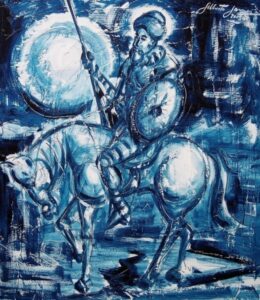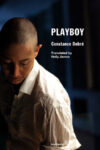On the surface, the five finalists for the 2021 National Book Awards for fiction represent an array of distinct literary voices. Anthony Doerr’s Cloud Cuckoo Land is a speculative novel that links five characters across space and time. Lauren Groff’s Matrix, a work of imaginative historical fiction, portrays Marie de France in charge of a nunnery, while Robert Jones, Jr.’s The Prophets depicts a romantic relationship between two enslaved men on a southern plantation. Laird Hunt’s Zorrie takes inspiration from Flaubert’s “A Simple Heart” in describing the hardscrabble life of a woman in mid-twentieth century Indiana. And, finally, Jason Mott’s Hell of a Book, which won the award, is set in the present and interweaves the story of a touring Black novelist with the experience of a young Black boy in South Carolina.
These novels are different from one another, there’s no disputing that, and yet in spite of their varied settings, styles, and themes, they are united by a profound commitment to centering their protagonists. The core feelings and ideas these books convey are funneled through the particular lives of finely-drawn characters. This, I argue, is one of the signal features of contemporary literature. It can be a challenging phenomenon to recognize, however, since it isn’t new but rather represents the long-term consolidation of modern Western literature’s emphasis on the individual.
That emphasis was present at the very beginning, with Don Quixote (1605, 1615), Robinson Crusoe (1719) and other early novels distinguishing themselves by replacing the allegorical figures of medieval literature with particular individuals in more-or-less realistic settings. Authors in the nineteenth century, when literary realism came into its own, built on this foundation by developing ever more sophisticated ways for depicting the psychological depths of the protagonist.
Literature in the twentieth century countered this inheritance, through efforts to destabilize characterization, but also refined it even further. Modernism jettisoned omniscient narration—with its built-in distance between the narrator and the world of the text—in favor of an impartial third-person limited perspective that kept narrative attention more closely linked to the protagonist. Then, in the postwar period, the significance of the protagonist was further affirmed, as Mark McGurl has shown, via an increased commitment to the highly subjective mode of first-person narration (e.g. Phillip Roth). And that brings us to the present, which has embraced only the protagonist-affirming dimensions of twentieth-century literature, further fueling an intense and pervasive attachment to the possibilities of personhood.
A measure of this development is that all of the notable literary directions and turns in recent years are invested in deepening and expanding the function of the protagonist. Take, for instance, the multi-strand narrative, which has been used in a number of prominent works of traditional and genre-bending literary fiction (Zadie Smith’s NW [2012], Ben Lerner’s The Topeka School [2019], David Mitchell’s Cloud Atlas [2004], etc.). Whatever other significance such novels may have, they are defined by their capacity to create multiple protagonists within the parameters of a single work. Each character is usually accorded their own discrete section(s) in the text, so that they can secure the full attention of the narrative, and first-person or third-person limited is used in order to foreground the immediacy of their individual experience. (This is the case even when the focus is on connecting protagonists, given that such connection serves to amplify each individual character.) By creating many fully-developed protagonists, the multi-strand text offers maximal fulfillment of the general literary aspiration—growing more emphatic in recent years—of giving readers an opportunity to connect with many other different lives.

The most prominent manifestation of our protagonist-centered moment is the much-discussed phenomenon of autofiction. Its signature feature—the blurring of the author and the protagonist—creates a profound deepening of individuality. Autofiction protagonists have built-in significance because, through their authorial counterparts, they always already have a life of their own. Ultimately, though, there is no corner of the current literary landscape in which protagonist-centered fiction is not present. One can look, for instance, at science fiction, a genre in which event-driven narratives used to be fairly common (e.g. Ray Bradbury’s The Martian Chronicles [1950]) but which is now overwhelmingly committed to character-driven work. This approach to literature is present even in the contemporary avant-garde practice of conceptual writing which is opposed to individual expressivity but not to giving the individual pride of place in the work (e.g. Kenneth Goldsmith’s Soliloquy [1997]).
Protagonist-centered fiction has further entrenched Western literature’s abiding interest in putting the resources of language at the service of the protagonist. Diction, syntax, and other elements bend toward the main character like a plant toward the sun. The protagonist doesn’t just occupy most, or all, of narrative space, but, more importantly, fills that space up with their own particularity. The result is that when they look out beyond themselves, the world they encounter appears to have an interest in their moods and fortunes.
I see protagonist-centered fiction as a spectrum category with individual texts embodying the above formal characteristics to varying degrees. While mainstream literary realism provides some of the fuller examples, this is not a strictly realist phenomenon. That is, it often involves evoking the depths of an individual—a realist technique whose pervasiveness grows and grows—but that is not an absolute requirement. The key, ultimately, is attention; intense and sustained narrative attention on the story of an individual. Such attention is a fixture of work published in The New Yorker and The Paris Review, but it also has a place in edgier publications like Conjunctions and NOON. The conflict between realism and its alternatives may still be going strong, but when it comes to the centrality of the protagonist, there’s no conflict, only agreement.

There are a number of authors whose work exemplifies protagonist-centered fiction, and at the top of the list is George Saunders, who is as close to a bellwether writer as we currently have. He is widely-praised for his craftsmanship and whimsical conceits, but, above all, it is the profound humanity of his writing that receives particular emphasis. This is not merely a matter of his insight into the human condition, but, more significantly, of the way his formal decisions are geared toward giving maximal attention to his protagonists. His work, especially from the last decade, minutely registers the rhythms and contours of individual personalities. His plots do not just revolve around his protagonists, they emerge from them, as he affirmed in a recent essay on his writing process: “Writing this story, I discovered a trick I’m still using to this day: if I make a person in enough detail, this creates plot.”
Saunders’s 2017 novel Lincoln in the Bardo is a powerful demonstration of the possibilities of protagonist-centered fiction. Instead of one main narrator, there are three, and they depict the action in a kind of stereophonic narrative mode with each supplying a detail from his perspective before another takes over. Three witnesses instead of one makes for a fuller record of the scene; there is literally more of the protagonists for the reader to perceive. Bardo also engages in a profound experiment to test how many protagonists a novel can contain without becoming unmoored. Nominally a story about the president grappling with the death of his eleven-year-old son Willie, it makes room for dozens of other life stories each told by a highly-individuated character. In effect, Saunders distributes narrative attention so as to give the protagonist-treatment to as many characters as possible, a formal procedure motivated by the notion that every human life is meaningful and deserves its turn in the spotlight.
Even when not explicitly stated, this ethical charge is a hallmark of protagonist-centered fiction, and it is particularly poignant in the work of authors representing historically marginalized groups. I’m thinking, just to give one example, of the beginning of Carmen Maria Machado’s acclaimed short story “The Husband Stitch” (2014), which features a play-like rundown of the key personages, with the first-person narrator describing herself in this way: “as a child, high-pitched, forgettable; as a woman, the same.” By centering the experience of this protagonist, the story targets and seeks to overcome her forgettable condition. Her life may be one of narrow opportunities and stifling social expectations, but here in this story she can assert herself and become, as she has, an indelible figure. Narrative attention becomes attentive concern in a potent illustration of the way literature can push back against the inequities of the world.
It’s not surprising that this sort of resistance has become a primary function of contemporary literature as a whole. We are living, after all, in a period where social structures and global forces are geared toward cutting people down to size. Late capitalism renders us more interchangeable than ever, while climate change is an active threat to present and future possibilities for a decent, stable life. There are identity-based discriminatory structures—white-supremacy, patriarchy—that severely limit individual potential. And this is all in addition to perennial factors that promote a sense of human smallness such as the recognition of the immense temporal and spatial scales of the universe.
Protagonist-centered fiction seeks to compensate for this dispiriting state of things by elevating and emphasizing the protagonist. My purpose is not to dismiss this approach—it has obviously made for some powerful fiction—but rather to argue that its dominance precludes full engagement with the conditions of the present moment. This is a historical conjuncture that’s shaped by the pressures of large structures and forces, and yet our literature operates almost exclusively at the scale of the individual. The limitations of this focus are most forcefully articulated in critiques of a small set of writers associated with navel-gazing literature—Tao Lin! Sally Rooney!—but, in truth, the tendency to privilege the protagonist is omnipresent.
In thinking about alternatives to protagonist-centered fiction, it is not enough to simply call, say, for the rejuvenation of the social novel as a means of depicting scales of knowledge beyond the individual. After all, many social novels (Dickens being a prime example) still filter their engagement with social problems through the travails of the main character. To avoid this sort of impasse, I am proposing a way of making literature that does not center the protagonist. Specifically, fiction that literally sidelines the individual without losing some connection to the traditional elements of fiction (i.e. more-or-less stable setting, coherent plot, legible characters, etc.). This is a kind of literature—what I’m calling non-protagonist-centered fiction—in which the particularity of protagonists isn’t necessarily reflected in the fictional worlds they inhabit, nor are they accorded as much space in the text as one would expect them to have. Or, as I show below in my reading of Shirley Jackson’s “The Lottery,” there is no protagonist at all. The perspective of the individual can have a place in such literature, but it does not anchor the narrative. Instead, the non-protagonist-centered text dramatizes how individuals are caught up in and reduced by large events, social structures, enormous timescales, agglomerations of people (the crowd, the mob), or just by their immediate surroundings. The key is that the reductive power of these forces, events, and structures is not merely described but formally enacted by limiting the amount of narrative attention the individual receives. So, for instance, if the “The Husband Stitch” were rewritten according to this model, the text would be structured in such a way as to actually perform the forgettable condition that the protagonist ascribes to herself.
There is no discernible tradition of non-protagonist-centered texts, but there are some interesting examples, and they can be found across national literatures, time periods, and movements. A great advantage of non-protagonist-centered fiction is that it isn’t tied to any particular style. It is a constraint-based aesthetic in that limiting the role of the protagonist in the text is the only necessary condition. This kind of literature can be written in practically any genre, which means that there are many possibilities for the shape it can take. Below, I analyze some extant examples to demonstrate how non-protagonist-centered fiction works and what it can do. My aim, with these readings and the essay as a whole, is to encourage writers to explore this form and develop its potential.
*
At its outset, Natalia Ginzburg’s Voices in the Evening (1963) establishes a common novelistic problem: Elsa, the first-person narrator, is twenty-seven and unmarried. We learn a few things about her, including that she’s been recently seen with a young man, and then the novel takes an unusual turn. Elsa should be the protagonist, or at least a protagonist, but after some initial scenes the narrative swerves away from her for the next fifty-five pages (nearly half of its total extent). In that long section, Elsa functions as an omniscient narrator—more nowhere than everywhere—who is tasked with describing the fortunes of the local factory-owning De Francisci family from the 1930s to the 1950s.
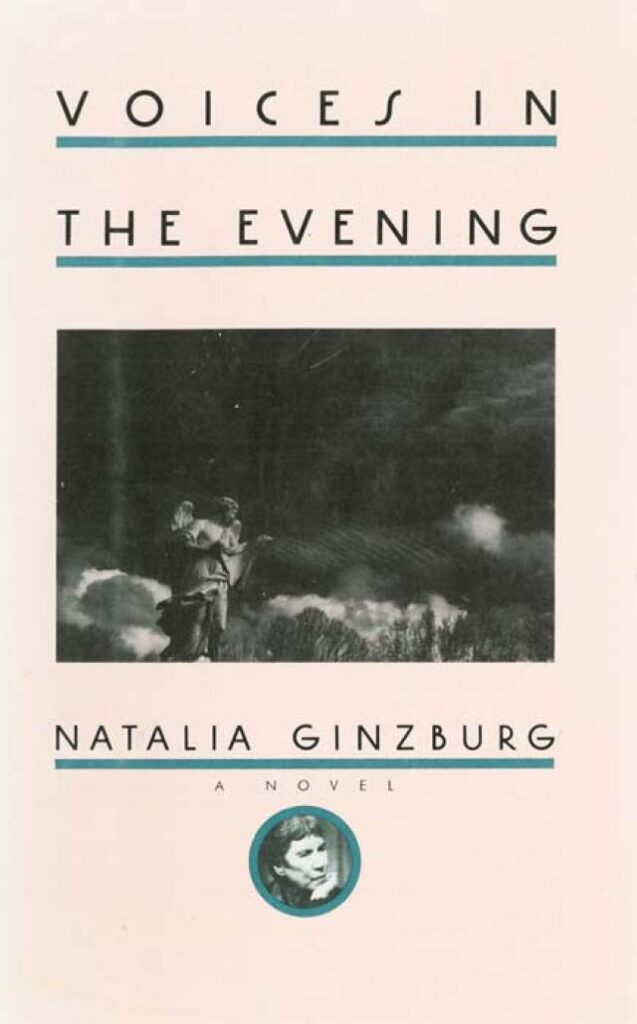
One would think that here among the De Francisci’s a true protagonist would emerge, but this is not that kind of novel. The unfortunate lives of the clan are catalogued in the cool and clipped manner of reportage: “Xenia fell ill after this and they removed her womb. She recovered and took up once more her sculpture, painting, and walks with the pet dogs.” One after another, the lives of the family members are briskly rendered with banal and momentous details receiving equal amounts of attention
It can be the case with protagonist-centered fiction that time, as an independent force, is muffled by deep engagement with the particular experiences of the hero or heroine. Narrative attention is organized in such a way that dramatic incidents and their ramifications assume monumental proportions that create a sense of timelessness. In this novel, on the other hand, a large temporal scale attains formal centrality so that months and years of a character’s life can pass in the space of a page or even a paragraph. The palpable, headlong movement of time serves to reduce the scope and significance of even the most important life-events.
The Western prose tradition may be grounded in amplifying the individual, but the kind of leveling effect described here does have a presence within it. In her recent book Flat Protagonists, Marta Figlerowicz uncovers that presence by demonstrating how protagonists from a wide-range of canonical literature—including Oroonoko (1688) and In Search of Lost Time (1913-1927)—fail to attract the full interest of the worlds they inhabit. These protagonists “are accorded plentiful narrative attention” but cannot use that space to create the impression of complex, deep, and emblematic individuality. While prevailing accounts of the moral significance of the realist novel stress its capacity to heighten interpersonal awareness, Figlerowicz puts forward a compelling, alternative moral vision. The protagonists she focuses on are marked by “personal finitude” and thus warn us about the kind of excessive self-regard that can generate outsized ideas about capturing the interest and sympathy of other people. In other words, they constitute an object lesson in humility.
It’s a quality that is baked into the structure of Voices in the Evening, which is related to but distinct from the lineage Figlerowicz describes because its mode of enacting the limited self is rooted in structurally withholding narrative attention. When at last Elsa remerges as a first-person narrator, she describes her unhappy love affair with the youngest of the De Francisci family, Tommasino. The affair receives more granular scrutiny than other character dynamics but not the singular focus that it would seem to deserve. Brief, fraught conversations between the two lovers are interspersed with scenes that are monopolized by Elsa’s flighty and domineering mother. Elsa is devastated by Tommasino’s lack of real love for her, but she is denied the narrative space for any significant reflection let alone reckoning. The novel ends as it began, Elsa walking with her mother, listening silently as the other delivers a lengthy, disconnected monologue in which she doesn’t figure at all.
Through her non-protagonist-centered approach, Ginzburg enacts the way that characters can be reduced by the world and its structures. As the youngest children in their respective families, Elsa and Tommasino are squeezed out of the narrative by the weight of their older siblings’ lives. Elsa, additionally, bears the imprint of a deeply patriarchal world. Unlike Tommasino, who’s at least granted some interests, Elsa matters only in terms of her marriageability, and so she occupies a very thin presence in the text. In general, Ginzburg’s evacuation of the individual serves to give voice to social and temporal forces that severely limit human potential. To read this novel is to experience how familial and temporal pressure can inhabit and profoundly structure every corner of a person’s life. Such pressure can be loud and large, but more often, as this novel teaches us, it is subtle and silent, denying its victims even the dream of a self-affirming response.
*
Non-protagonist-centered literature can be particularly powerful in depicting the monstrous possibilities of collective social units. Instead of focalizing a crowd or a community through an exemplary individual, such literature reminds us that groupings of this sort have their own independent ontology, consisting of individual experiences but also superseding them. Such is the lesson of one of the most celebrated short stories of the twentieth century, Shirley Jackson’s “The Lottery.”
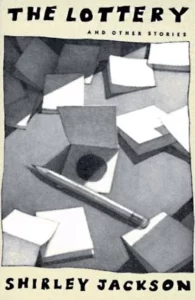
Published in 1948 in The New Yorker, it describes a village as it undertakes an annual lottery to determine who among its inhabitants will be stoned to death. What makes the story so shocking is that the dark purpose of the lottery is not revealed until the very end and there is not much in the way of build-up. Jackson focuses narrative attention mainly on the banal details of the ritual: “Mr. Summers had been successful in having slips of paper substituted for the chips of wood.” Without knowing what the lottery is all about, we learn that many of its elements “had been forgotten or discarded” over the years and that, as a Mrs. Adams asserts, “‘Some places have already quit lotteries.’” And yet, in this village, the lottery proceeds, its mechanical rhythms bull-dozing any villager’s mildly-voiced reservation.
All the characters in this story are salt-of-the-earth-types eager for the lottery to end so that they can get back to work. Not one of them claims any particular narrative interest, not even the victim, Mrs. Hutchinson. When her husband draws a marked piece of paper—meaning someone from his family will have to be sacrificed—she yells at Mr. Summers, the lottery administrator: “You didn’t give him time enough to take any paper he wanted. I saw you. It wasn’t fair!” She repeats that last phrase when she draws the short end of the stick, and again, in the very last sentence, as the villagers descend upon her: “It isn’t fair, it isn’t right.”
What’s notable about these complaints is that they focus wholly on the process of the lottery. “I think we ought to start over,” she says, implying that in this particular case the lottery has not been conducted properly. She does not—she isn’t allowed to—say anything that would discredit the lottery as such. To the very end, Mrs. Hutchinson is compelled to voice her community’s enduring commitment to this yearly ritual.
And, for a while at least, so is the reader. Faced with Mrs. Hutchinson’s complaints, it’s hard not to affirm the fairness of the lottery. After all, the narrative is very transparent and thorough in its depiction of how the event is carried out, and everything does appear to be above board. In effect, the reader is drawn into the mental space of the village, caught up in the minutiae of the ritual and the irrelevant concerns about fairness, until the finale when you’re abruptly freed to see the community in a different, terrible light.
In “The Lottery,” and non-protagonist-centered fiction in general, the process of identification, whereby a reader becomes invested in a text, is distributed beyond its usual grounding in the character to other textual elements. In a recent essay, Rita Felski develops an expanded conceptualization of identification, arguing that it can be partial, qualified, and/or ironic—i.e. not just a matter of one-dimensional empathy. While Felski focuses on identification in terms of character, she acknowledges that it does not have to rely on “person schemas” and, indeed, non-protagonist-centered fiction offers ample proof for that notion. The characters in “The Lottery” are too non-descript and lightly present for the reader to identify with their individual fates. Instead, it’s the community as a whole—the way it’s constituted, the way it functions—that consumes your interest and attention. After briefly aligning yourself with its perspective on the fairness of the lottery, you see it for what it is: a machine that has suppressed personal autonomy such that individuals are no more than flat, compliant, and fleeting entities. Identification, here, is a matter of relating this particular instance of collective terror to what is possible in the world you inhabit. And this is especially instructive in the present moment where toxic ideologies lead people to lose themselves in unpredictable and dangerous social groups.
*
It is not an accident that thus far my examples of non-protagonist-centered fiction are from the immediate post-WWII period. It was, after all, during this time that the bourgeois commitment to the sovereign subject was being challenged by a wide-array of prominent thinkers including Theodor Adorno, Jean-Paul Sartre, and Roland Barthes. A notable figure in this group, as both a theorist and a novelist, was the French writer Alain Robbe-Grillet. His novels—with their hypnotic repetitions, flat surfaces, and kaleidoscopic chronologies—were met with hostility from most readers and critics, leading him to write a series of essays in which he defended his work and, in the process, mustered a powerful case for literature that does not put itself at the service of the protagonist.
In 1950s France, Robbe-Grillet was up against a literary scene that was dominated by the realist novel. Most of the fiction being published ignored modernist innovations and allied itself with the Balzacian tradition in which characters, settings and other narrative elements are organized into an orderly schema informed by received significations. More than anything else, such fictions communicated a sense of mastery over reality. And that, for Robbe-Grillet, was the problem. The illusion of mastery ignored a true reckoning with what he believed to be the most meaningful feature of the world: that it is simply there, that it has an independent existence beyond any meaning we can ascribe to it.
For the novel, the ramifications of this phenomenological insight include the notion that the object world cannot be depicted as merely a reflection or illustration of the protagonist’s fate. Further, if the individual cannot be figured as standing over and above the world, it is not actually realistic for a protagonist to receive ontological pride of place in a text. Robbe-Grillet’s call for decentering literary characters jibed with a historical juncture which, in the aftermath of WWII, was informed by skepticism about humanist ideals. As he writes in his essay “On Several Obsolete Notions”: “Our world, today, is less sure of itself, more modest perhaps, since it has renounced the omnipotence of the person . . . the exclusive cult of the ‘human’ has given way to a larger consciousness, one that is less anthropocentric.”
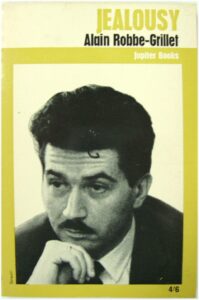
Robbe-Grillet’s 1957 novel Jealousy provides a fascinating example of the possibilities that open up for literature that sidelines the human. The very title of the book creates certain firm readerly expectations given that jealousy is an affective state that has an established profile in Western culture. It is usually depicted as an all-consuming emotion that not only burns up the jealous individual—Othello is the classic example—but also spills out and stains the surrounding world. The victim sees his or her betrayal everywhere, a notion captured by the deeply-rooted tendency to treat jealousy, in the guise of the color green, as a property of vision (in The Merchant of Venice, Portia speaks of “green-eyed jealousy”; while Iago, ironically warning Othello, calls jealousy a “green-eyed monster”).
Jealousy is written in Robbe-Grillet’s characteristic disjunctive style, but, really, the most challenging aspect of the novel is its iconoclastic depiction of jealousy. Set on a banana plantation, the novel is nominally concerned with an affair between the narrator’s wife and a man named Franck. The unnamed narrator is an absent presence in the text—everything is told from his point-of-view but even in scenes with other characters he does not possess any sort of embodiment. The novel consists of the repetition of certain incriminating scenes—the wife and Franck sitting a little too closely together on the veranda, the two of them exchanging a possibly meaningful look over dinner, etc.—but there is no ratcheting up of tension and no heated confrontations. Damning scenes occur again and again but the issue is never brought to a crisis.
In fact, whenever the narrative approaches anything resembling dramatic build-up, it swerves away and directs its attention elsewhere. There are, for instance, obsessively detailed descriptions of the veranda balustrade with its variegated surface of “scaly zones” and smooth planes. The narrator focuses minutely on the objects of his home as well as on the natural world, particularly the surrounding banana trees. There are pages devoted to a meticulous accounting of these trees, the kind of landscapes they inhabit, how many there are in a given patch in a given row and so on.
These descriptions are strangely thrilling. The surrounding natural world, in the form of the lush green surfaces of the banana trees, would seem perfectly suited to serve as a metaphorical extension of the narrator’s jealousy. But instead there’s only bare description which scrupulously avoids any sort of anthropomorphic analogy. The natural world thus retains its independence, and, as the mesmerizing descriptions build, begins to suggest that it possesses a significance of its own that has nothing to do with human affairs. Such open-endedness, such palpable distance from human-made meaning, ultimately invites the reader into a profound experience of freedom.
In his essay “Nature, Humanism, Tragedy,” Robbe-Grillet writes that, within non-anthropomorphic parameters, “man looks at the world, and the world does not look back at him. Man sees things and discovers, now, that he can escape the metaphysical pacts others had once concluded for him, and thereby escape servitude and terror.” In Jealousy, Robbe-Grillet puts this idea into action by turning away from received ways of experiencing the titular emotion. In the usual cultural script, jealousy is figured as a form of madness that eats a person up, and while that is, obviously, a way in which jealousy can manifest itself, it doesn’t have to be that way. In other words, as Robbe-Grillet leads us to see, there is nothing natural or essential about jealousy as an all-consuming force. It is not possible to say whether the narrator is affected at all by this freedom-generating notion—he remains perfectly impassive throughout the narrative—but certainly it has an impact on the reader, who sees that jealousy, or any other extreme feeling, may arise but does not have to dominate their world. And so, while Jealousy is often thought of as a cold novel, not least because of the way it decenters its protagonists, it can actually be seen as possessing a powerful therapeutic purpose.
*
There are some contemporary texts incorporating the non-protagonist-centered mode, and below I examine two interesting examples. Like a lot of literature now, these novels use first-person and third-person limited and are multi-strand narratives. One of my goals in analyzing these particular examples is to show that omniscient narration is not a necessary condition of non-protagonist-centered fiction. It is possible to write in this mode within any point-of-view framework. The key, as always, is that the protagonist is literally reduced such that they do not dominate narrative space.

Hiroko Oyamada’s matter-of-factly surreal novel The Factory (2013) features three protagonists, each allotted their own sections in the text, describing their experiences as employees at the titular institution. It’s an unsettling place to work at, occupying an enormous and vague physical space with myriads of buildings as well as a forest, a river, and somehow an ocean. There’s also something very off about the responsibilities assigned to these three college-educated white-collar workers. They edit already-edited documents, shred random pieces of paper, and perform other tasks that are always pointless and usually also absurd.
Despite the use of the first-person, the reader can’t get much of a sense of the protagonists as individuals and that’s because the narrative severely limits their opportunities for self-expression. Forced to devote all their attention to the bizarre conditions of their jobs and the factory as a whole, they are denied the space necessary to engage in reflection and develop themselves as legible characters. Such limitations become especially apparent in a recurring narrative situation where a protagonist, encountering some weird circumstance, asks a colleague for clarification. As a rule, the response they receive is not just evasive and obfuscatory but also long-winded. The protagonist is thus crowded out of their very own narrative and restricted to weak expressions of befuddlement and resignation.
In effect, Oyamada enacts the experience of being locked into what David Graeber has defined as a bullshit job. The protagonists perform work that is entirely unnecessary and meaningless but they are compelled to maintain the pretense that it fundamentally matters and that they are grateful to be employed. A further twist of the knife is that anyone can do this work. This is especially galling for the oldest protagonist, Yoshio Furufue, who had previously worked as an academic researcher focusing on bryology. At the factory, however, he is assigned the simple and absurd task of organizing expeditions to find moss on the factory campus.
In a capitalist world where work and identity are closely aligned, if not one and the same, to have a meaningless job is to feel meaningless as a person. There’s a sense of smallness and insecurity which impedes the capacity to assert oneself. The Factory dramatizes this condition by drawing attention away from its protagonists, an especially fitting and poignant technique given the prevalence in our societies of the capitalist logic that aligns attention with value. This text also provides a clear demonstration of the significant possibilities for readerly identification that non-protagonist-centered fiction makes available. What draws our attention is not so much the protagonists themselves as the process of their attenuation; and, further, their lack of presence in their very own narratives allows the reader to slide from the personal into the structural problems that the novel presents. What comes to the fore is the miserable condition of work under capitalism. The limitless extent of the factory stands for the inescapability of a system of values that is entirely foreign to human flourishing. As one of the protagonists dejectedly puts it: “Life has nothing to do with work and work has no real bearing on life.” And it is this whole impossible situation that becomes animated in the world of The Factory.
*
So far I have focused on works located squarely within the parameters of non-protagonist-centered fiction, but I want to stress that there is nothing exclusive about this form. That is, it is possible to integrate it, to one degree or another, with elements of protagonist-centered fiction. This sort of melding can produce compelling literary effects as demonstrated by Jenny Erpenbeck’s novel Visitation (2008).
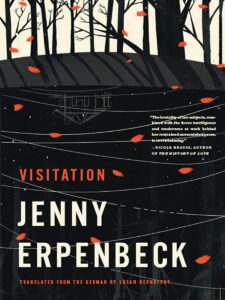
The book is set on a lakeside property just east of Berlin and focuses on the upheavals of the twentieth century. But before getting there, we are plunged, in the prologue, into the prehistoric past. Twenty-four thousand years ago, a glacier arrived at this location and over subsequent centuries it carved large channels into the ground, one of which turned into the lake that centers this novel’s narrative attention. Erpenbeck thus frames the human drama that follows as one small interval in a much vaster geological history. The result is that human affairs are starkly relativized and denied the kind of intensely self-contained characterization that can produce a general mood of self-importance. From a geological perspective, after all, the total end of those affairs—i.e. the obliteration of any material trace—is not very far from its beginning: “like every lake, it too was only temporary—like every hollow shape, this channel existed only to be filled in completely someday. Even in the Sahara there was water once.”
After this opening, we are brought back within the span of human history and introduced, in a one-page chapter, to the figure of the gardener. No one knows much about him, not even when he arrived in this part of the world, but he knows his trade very well and proves to be an asset in the effort to drain the land along the lake so that homes can be built there.
At first glance, the gardener would seem to be just another minor character. He fits the mold of a type that Alex Woloch in his book The One vs. the Many describes as “the worker”—i.e., a “flat character who is reduced to a single functional use within the narrative.” In his systematic conceptualization of minor characters, grounded in the nineteenth-century realist novel, Woloch demonstrates how the limited individuality of these figures is a function of their relatively limited position in the text. Potentially, every character could have a rich past and a deep interiority, but the scarcity of narrative attention means that at most only a select few will receive the protagonist treatment. Woloch relates the uneven distribution of attention to the uneven distribution of resources and possibilities in capitalist societies. Worker minor characters—and the gardener, in general, is a classic example—are subservient figures whose labor paves the way, in numerous ways, for the full individual development of the protagonist(s).
But in Visitation this relationship is turned on its head. After the opening sections, every other chapter in the book is devoted to a particular individual whose life is destroyed or at least disturbed by WWII, the Holocaust, and the Cold War. But if these chapters are grounded in protagonist-centered fiction, the end of each one leads to another chapter on the gardener, marked by a very different mode of writing. As the twentieth century unfolds, and different characters inhabit and then are forced to leave the property, the gardener remains in place, essentially untouched by the currents of history. The circumstances of his work change over time, and he has to limit his activity as he ages, but otherwise there’s a striking regularity to his life: planting in the spring, watering in the summer, raking leaves and chopping firewood before fall turns to winter, and the process repeats itself. Unlike the other chapters, where we are plunged into the interiority of a protagonist, the gardener is depicted strictly in terms of his labor. We never hear him speak, we never learn anything about him as a person; the rhythms of the writing in his chapters evoke not an individual personality but rather the cyclical effort of caring for the land.
And yet, he is not really a minor character. The chapters devoted to the gardener are relatively short, but, taken together, they come to twenty-five pages of this 150-page book. The gardener is accorded more than twice the amount of narrative space, in terms of pages, that any of the fully-developed protagonists receive. Given this relatively large role, it makes sense that unlike the typical “worker” he does not occupy a subordinate position vis-à-vis the protagonists. He may be engulfed by his function, but it can’t be said that he is exploited since, ultimately, he belongs not to any of the inhabitants of the property but to the land itself.
The gardener’s notable freedom from subservience creates a role for him in the narrative that serves to reduce and relativize the plights of the clearly demarcated protagonists. Their stories center on dramatic, life-consuming tragedies; each of these protagonists, in fact, could be the subject of his or her own novel, and yet, they each get only a brief chapter before we are once more brought back to the gardener and his relatively undisturbed trajectory through the twentieth century.
Visitation is a novel that is deeply invested in what I call the aesthetic of meanwhile. The protagonists are caught up by monumental historic events but the narrative takes pains to remind us that these events and their victims are not the whole story, that there is always something else going on, including the radically different outcomes of other lives. This aesthetic also refers to different temporal scales, like the geological time that the novel establishes in its opening. Importantly, the act of drawing attention away from the protagonists—by bringing various meanwhiles into the frame—functions, paradoxically, to amplify readerly interest in their fates. The formal procedure of sidelining these characters creates potent and moving illustrations of the frailty, evanescence, and random bad luck of human life.
*
In this essay I have sought to show non-protagonist-centered fiction in practice and to highlight its particular suitability as an alternate means of registering and responding to the present. The fact that this form has not been very common in literary history is an advantage as it leaves a lot of room for further exploration. There are interesting opportunities, for instance, for a dialectical blending of protagonist-centered fiction and its opposite (as illustrated by Visitation). At the other end of the spectrum, we can think about the kind of literature that can emerge by pushing non-protagonist-centered fiction to its limit. How minimally-present can a protagonist be in a text? In a short story, given its limited extent, it’s possible to avoid a protagonist altogether—but could that be done in a novel?
These are stimulating questions that can engender truly new and different literary forms and give us greater insight into the human condition in its relation to the world. This last point is crucial. While non-protagonist-centered fiction runs counter to the humanist impulse to center the protagonist, it is not anti-human by any stretch of the imagination. The works discussed above are very much invested in communicating human experience, but what distinguishes them, and non-protagonist-centered fiction as a whole, is that they try to do so without leaning unduly on the perspective of an individual.
Finally, I want to briefly touch on the issue of aesthetic experience. That is, what’s it like to read non-protagonist-centered fiction? There can be no single definitive answer to this question given that this is a form that lends itself to many different styles and genres of literature (from straight-ahead realism to absurdist and speculative fiction with different kinds of narrative points-of-view and affective registers). Still, I can say there is a baseline experience that emerges from the realization that something very important—the protagonist!—is missing or just not present in the way we would usually expect. And, simultaneously, there’s the tenacious thought that through this absence something else has become available. The literary text becomes a truly uncertain terrain, and it is thrilling, for the reader, to witness how it will fill all that vacated space.
Semyon Khokhlov is starting a magazine—LEAN—devoted to non-protagonist-centered fiction. It will be published online and focus on short-fiction (broadly conceived). Contributors will be paid! If you have work that fits within the non-pcf mold, please send it along for consideration to leanmagazine33[at]gmail.com.
This post may contain affiliate links.



